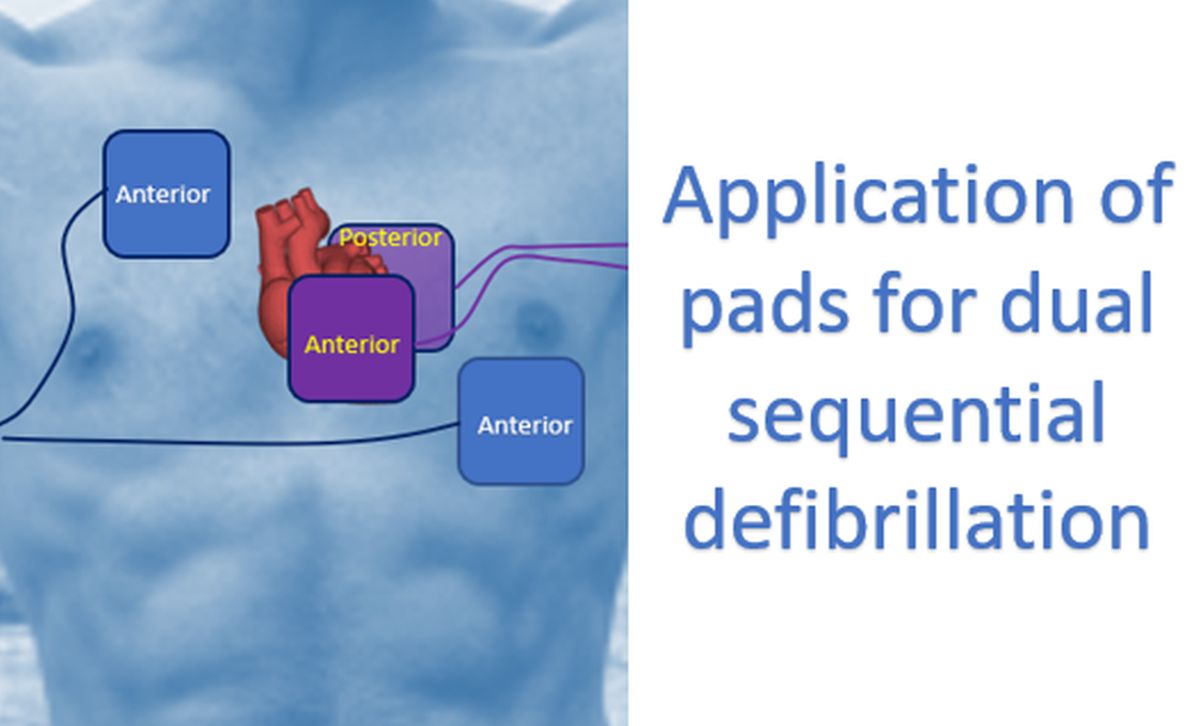What is double sequential defibrillation?
What is double sequential defibrillation?
Double sequential defibrillation, also known as double sequential external defibrillation is the application of two shocks using two defibrillators nearly simultaneously, for refractory ventricular fibrillation. There are several variations in the techniques. Generally they use two shock vectors with two sets of defibrillation patches or paddles. First set of patches are usually applied in anterior-anterior locations and the second set in anterior-posterior locations.

The DOSE VF pilot was cluster randomized controlled trial with crossover in four Canadian paramedic services including all treated adult out-of-hospital cardiac arrest patients who presented in ventricular fibrillation and received a minimum of three consecutive defibrillation attempts [1]. Each emergency medical service was randomly assigned to provide standard defibrillation, vector change defibrillation or double sequential external defibrillation. Agencies crossed over to an alternate defibrillation strategy after six months.
A total of 152 patients were enrolled. 89.5% of cases received the defibrillation strategy they were randomly allocated to. 93.1% of cases received a vector change defibrillation or double sequential external defibrillation prior to the sixth defibrillation attempt. No safety concerns were reported in the study. 66.6% had termination of ventricular fibrillation in the standard group, compared to 82% in vector change defibrillation and 76.3% in the double sequential external defibrillation group. Achievement of return of spontaneous circulation (ROSC) was 25%, 39.3% and 40% respectively in these groups.
Authors concluded that DOSE-VF protocol is feasible and safe. Rates of termination of ventricular fibrillation and ROSC were higher in vector change defibrillation and double sequential external defibrillation than in standard defibrillation.
A systematic review of double (dual) sequential defibrillation for refractory ventricular fibrillation cardiac arrest found four cohort studies, three case series, one case-control study and a prospective pilot clinical trial [2]. Authors considered all studies to have serious or critical risk of bias and hence no meta-analysis was performed. They could not find any differences in terms of neurological outcome, survival to hospital discharge, survival to hospital admission, ROSC or termination of ventricular fibrillation/pulseless ventricular tachycardia between double sequential defibrillation and standard defibrillation strategy.
They concluded that the use of double sequential defibrillation was not associated with improved outcomes from out-of-hospital cardiac arrest. They suggested that further high-quality evidence is needed to answer this important question.
DOSE VF will be a three-arm cluster randomized trial with repeated crossover over 3 years. Pattern of shocks will be like the DOSE VF pilot study mentioned initially [3]. The primary outcome will be survival to hospital discharge. Secondary outcomes will include ROSC, termination of ventricular fibrillation after the first interventional shock, termination of ventricular fibrillation inclusive of all interventional shocks and the number of defibrillation attempts to obtain ROSC.
Vector change defibrillation involving an anterior and posterior pad placement is likely to create higher voltage gradient in the posterior part of the ventricle. This vector path includes the interventricular septum and may require lower energy levels to defibrillate. Different pathways can increase the current density in the lowest voltage areas after standard shocks [3].
2020 American Heart Association Guidelines for Cardiopulmonary Resuscitation and Emergency Cardiovascular Care mentioned that the usefulness of double sequential defibrillation for refractory shockable rhythm has not been established [4].
References
- Cheskes S, Dorian P, Feldman M, McLeod S, Scales DC, Pinto R, Turner L, Morrison LJ, Drennan IR, Verbeek PR. Double sequential external defibrillation for refractory ventricular fibrillation: The DOSE VF pilot randomized controlled trial. Resuscitation. 2020 May;150:178-184. doi: 10.1016/j.resuscitation.2020.02.010. Epub 2020 Feb 19. PMID: 32084567.
- Deakin CD, Morley P, Soar J, Drennan IR. Double (dual) sequential defibrillation for refractory ventricular fibrillation cardiac arrest: A systematic review. Resuscitation. 2020 Oct;155:24-31. doi: 10.1016/j.resuscitation.2020.06.008. Epub 2020 Jun 16. PMID: 32561473.
- Drennan IR, Dorian P, McLeod S, Pinto R, Scales DC, Turner L, Feldman M, Verbeek PR, Morrison LJ, Cheskes S. DOuble SEquential External Defibrillation for Refractory Ventricular Fibrillation (DOSE VF): study protocol for a randomized controlled trial. Trials. 2020 Nov 26;21(1):977. doi: 10.1186/s13063-020-04904-z. PMID: 33243277; PMCID: PMC7689391.
- Merchant RM, Topjian AA, Panchal AR, Cheng A, Aziz K, Berg KM, Lavonas EJ, Magid DJ; Adult Basic and Advanced Life Support, Pediatric Basic and Advanced Life Support, Neonatal Life Support, Resuscitation Education Science, and Systems of Care Writing Groups. Part 1: Executive Summary: 2020 American Heart Association Guidelines for Cardiopulmonary Resuscitation and Emergency Cardiovascular Care. Circulation. 2020 Oct 20;142(16_suppl_2):S337-S357. doi: 10.1161/CIR.0000000000000918. Epub 2020 Oct 21. PMID: 33081530.

